Hydro Statistical Assessment of TRMM and GPM Precipitation Products against Ground Precipitation over a Mediterranean Mountainous Watershed (in the Moroccan High Atlas)
Abstract
:1. Introduction
2. Materials and Methods
2.1. Study Area
2.2. Dem
2.3. Rain Gauge Data
2.4. Satellite Precipitation Data
2.4.1. TRMM 3B42 V7
2.4.2. GPM IMERG V5
2.5. Statistical Evaluation of Satellite Precipitation Products
2.5.1. Continuous Statistical Indices
2.5.2. Categorical Statistical Indices
2.6. Hydrological Model
3. Results
3.1. Statistical Evaluation
3.2. Contingency Statistics
3.3. Hydrological Evaluation of Discharge Simulation Using Two SPPs
3.3.1. Event of 20 November 2014
3.3.2. Event of 21 March 2016
3.3.3. Event of 3 May 2016
3.3.4. Event of 16 December 2016
4. Conclusions
- (1)
- 3B42 V7 and IMERG V05 products performed well in estimating sub-hourly, daily, monthly, and annual precipitation compared to observed data from the Taferiat station. 3B42V7 underestimated low precipitation events but well estimated heavy precipitation with small time step. However, the monthly and annual precipitation were well captured. While IMERGV05 overestimates heavy precipitation episodes and has a good ability to detect low precipitation in small time step, the monthly and the yearly precipitation are well estimated by this product.
- (2)
- Compared to the ground applications, 3B42V7 and IMERG V5 showed acceptable correlation results at the sub-hourly and daily time scales. However, IMERG V05 performed slightly better than 3B42 V7 for the detection of sub-hourly and daily precipitation at the measuring station. The categorical statistical measures values showed high values of POD and CSI, as well as reasonably high values of FAR and FBI, noting that the results of the categorical measures are good. In general, IMERG V05 is better at detecting precipitation events, in particular at capturing precipitation traces and solid precipitation at a 3-hourly and daily scale, while 3B42 V7 can estimate precipitation on a large time scale.
- (3)
- The hydrological calibration and validation were performed according to two different scenarios; scenario 1 aims to simulate and calibrate events using rainfall from both satellite products with observed flows, while scenario 2 of validation uses the leave-one-out resampling approach; for the n flood events, in order to find the relationship between the root-soil moisture measured and the most sensitive model parameters (CN calibration, and time of concentration “TC”). The obtained results are satisfactory for all calibration and validation parts, the NSE coefficients ranging between 74.75% and 63.31%, respectively. The main point to remember is that the 3B42V7 product does not have a good ability to capture small rainfall events in a short time step, in fact, it underestimates the rainfall. On the other hand, the IMERG V05 product has an excellent capacity to record small rainfall events, which is well demonstrated in the validation graphs. Therefore, it is recommended to use this product for flood modeling and forecasting. The proposed method is an interesting approach to apply for solving the problem of insufficient observed data in the Mediterranean regions. The present manuscript provides a valuable reference for precipitation monitoring and forecasting in mountainous regions characterized by a Mediterranean climate, as well as in basins with few or poorly distributed rainfall stations.
Author Contributions
Funding
Acknowledgments
Conflicts of Interest
References
- Yuan, F.; Zhang, L.; Win, K.W.W.; Ren, L.; Zhao, C.; Zhu, Y.; Jiang, S.; Liu, Y. Assessment of GPM and TRMM Multi-Satellite Precipitation Products in Streamflow Simulations in a Data-Sparse Mountainous Watershed in Myanmar. Remote Sens. 2017, 9, 302. [Google Scholar] [CrossRef]
- Bollasina, M.A.; Ming, Y.; Ramaswamy, V. Anthropogenic Aerosols and the Weakening of the South Asian Summer Monsoon. Science 2011, 334, 502–505. [Google Scholar] [CrossRef] [PubMed]
- Zhu, G.; He, Y.; Pu, T.; Wang, X.; Jia, W.; Li, Z.; Xin, H. Spatial distribution and temporal trends in potential evapotranspiration over Hengduan Mountains region from 1960 to 2009. J. Geogr. Sci. 2012, 22, 71–85. [Google Scholar] [CrossRef]
- Xia, T.; Wang, Z.-J.; Zheng, H. Topography and Data Mining Based Methods for Improving Satellite Precipitation in Mountainous Areas of China. Atmosphere 2015, 6, 983–1005. [Google Scholar] [CrossRef]
- Jiang, S.; Liu, S.; Ren, L.; Yong, B.; Zhang, L.; Wang, M.; Lu, Y.; He, Y. Hydrologic Evaluation of Six High Resolution Satellite Precipitation Products in Capturing Extreme Precipitation and Streamflow over a Medium-Sized Basin in China. Water 2017, 10, 25. [Google Scholar] [CrossRef]
- Borga, M.; Anagnostou, E.; Blöschl, G.; Creutin, J.-D. Flash floods: Observations and analysis of hydro-meteorological controls. J. Hydrol. 2010, 394, 1–3. [Google Scholar] [CrossRef]
- Germann, U.; Galli, G.; Boscacci, M.; Bolliger, M. Radar precipitation measurement in a mountainous region. Q. J. R. Meteorol. Soc. 2006, 132, 1669–1692. [Google Scholar] [CrossRef]
- Hrachowitz, M.; Weiler, M. Uncertainty of Precipitation Estimates Caused by Sparse Gauging Networks in a Small, Mountainous Watershed. J. Hydrol. Eng. 2011, 16, 460–471. [Google Scholar] [CrossRef]
- Mei, Y.; Anagnostou, E.N.; Nikolopoulos, E.I.; Borga, M. Error Analysis of Satellite Precipitation Products in Mountainous Basins. J. Hydrometeorol. 2014, 15, 1778–1793. [Google Scholar] [CrossRef]
- Yi, L.; Zhang, W.; Wang, K. Evaluation of Heavy Precipitation Simulated by the WRF Model Using 4D-Var Data Assimilation with TRMM 3B42 and GPM IMERG over the Huaihe River Basin, China. Remote Sens. 2018, 10, 646. [Google Scholar] [CrossRef]
- Muzirafuti, A.; Cascio, M.; Lanza, S.; Randazzo, G. UAV Photogrammetry-based Mapping of the Pocket Beaches of Isola Bella Bay, Taormina (Eastern Sicily). In Proceedings of the 2021 International Workshop on Metrology for the Sea; Learning to Measure Sea Health Parameters (MetroSea), Reggio Calabria, Italy, 4–6 October 2021; pp. 418–422. [Google Scholar] [CrossRef]
- Chen, C.; Chen, Q.; Duan, Z.; Zhang, J.; Mo, K.; Li, Z.; Tang, G. Multiscale Comparative Evaluation of the GPM IMERG v5 and TRMM 3B42 v7 Precipitation Products from 2015 to 2017 over a Climate Transition Area of China. Remote Sens. 2018, 10, 944. [Google Scholar] [CrossRef]
- Muzirafuti, A.; Boualoul, M.; Barreca, G.; Allaoui, A.; Bouikbane, H.; Lanza, S.; Crupi, A.; Randazzo, G. Fusion of Remote Sensing and Applied Geophysics for Sinkholes Identification in Tabular Middle Atlas of Morocco (the Causse of El Hajeb): Impact on the Protection of Water Resource. Resources 2020, 9, 51. [Google Scholar] [CrossRef]
- Sorooshian, S.; Hsu, K.-L.; Gao, X.; Gupta, H.V.; Imam, B.; Braithwaite, D. Evaluation of PERSIANN System Satellite–Based Estimates of Tropical Rainfall. Bull. Am. Meteorol. Soc. 2000, 81, 2035–2046. [Google Scholar] [CrossRef]
- Joyce, R.J.; Janowiak, J.E.; Arkin, P.A.; Xie, P. CMORPH: A Method that Produces Global Precipitation Estimates from Passive Microwave and Infrared Data at High Spatial and Temporal Resolution. J. Hydrometeorol. 2004, 5, 487–503. [Google Scholar] [CrossRef]
- Guo, J.; Zhai, P.; Wu, L.; Cribb, M.; Li, Z.; Ma, Z.; Wang, F.; Chu, D.; Wang, P.; Zhang, J. Diurnal variation and the influential factors of precipitation from surface and satellite measurements in Tibet. Int. J. Clim. 2014, 34, 2940–2956. [Google Scholar] [CrossRef]
- Funk, C.; Peterson, P.; Landsfeld, M.; Pedreros, D.; Verdin, J.; Shukla, S.; Husak, G.; Rowland, J.; Harrison, L.; Hoell, A.; et al. The climate hazards infrared precipitation with stations—A new environmental record for monitoring extremes. Sci. Data 2015, 2, 150066. [Google Scholar] [CrossRef]
- Huffman, G.J.; Bolvin, D.T.; Nelkin, E.J.; Wolff, D.B.; Adler, R.F.; Gu, G.; Hong, Y.; Bowman, K.P.; Stocker, E.F. The TRMM Multisatellite Precipitation Analysis (TMPA): Quasi-Global, Multiyear, Combined-Sensor Precipitation Estimates at Fine Scales. J. Hydrometeorol. 2007, 8, 38–55. [Google Scholar] [CrossRef]
- Hou, A.Y.; Kakar, R.K.; Neeck, S.; Azarbarzin, A.A.; Kummerow, C.D.; Kojima, M.; Oki, R.; Nakamura, K.; Iguchi, T. The global precipitation measurement mission. Bull. Am. Meteorol. Soc. 2014, 95, 701–722. [Google Scholar] [CrossRef]
- Tong, K.; Su, F.; Yang, D.; Hao, Z. Evaluation of satellite precipitation retrievals and their potential utilities in hydrologic modeling over the Tibetan Plateau. J. Hydrol. 2014, 519, 423–437. [Google Scholar] [CrossRef]
- Ringard, J.; Becker, M.; Seyler, F.; Linguet, L. Temporal and Spatial Assessment of Four Satellite Rainfall Estimates over French Guiana and North Brazil. Remote Sens. 2015, 7, 16441–16459. [Google Scholar] [CrossRef]
- Chandrasekar, V.; Le, M. Evaluation of profile classification module of GPM-DPR algorithm after launch. In Proceedings of the 2015 IEEE International Geoscience and Remote Sensing Symposium (IGARSS), Milan, Italy, 26–31 July 2015; pp. 5174–5177. [Google Scholar] [CrossRef]
- Liu, Z.; Ostrenga, D.; Vollmer, B.; Deshong, B.; Macritchie, K.; Greene, M.; Kempler, S. Global Precipitation Measurement Mission Products and Services at the NASA GES DISC. Bull. Am. Meteorol. Soc. 2017, 98, 437–444. [Google Scholar] [CrossRef] [PubMed]
- Gebregiorgis, A.S.; Kirstetter, P.; Hong, Y.E.; Gourley, J.J.; Huffman, G.J.; Petersen, W.A.; Xue, X.; Schwaller, M.R. To What Extent is the Day 1 GPM IMERG Satellite Precipitation Estimate Improved as Compared to TRMM TMPA-RT? J. Geophys. Res. Atmos. 2018, 123, 1694–1707. [Google Scholar] [CrossRef]
- Rozante, J.R.; Vila, D.A.; Chiquetto, J.B.; Fernandes, A.D.A.; Alvim, D.S. Evaluation of TRMM/GPM Blended Daily Products over Brazil. Remote Sens. 2018, 10, 882. [Google Scholar] [CrossRef]
- Kim, K.; Park, J.; Baik, J.; Choi, M. Evaluation of topographical and seasonal feature using GPM IMERG and TRMM 3B42 over Far-East Asia. Atmos. Res. 2017, 187, 95–105. [Google Scholar] [CrossRef]
- Zhong, R.; Chen, X.; Lai, C.; Wang, Z.; Lian, Y.; Yu, H.; Wu, X. Drought monitoring utility of satellite-based precipitation products across mainland China. J. Hydrol. 2019, 568, 343–359. [Google Scholar] [CrossRef]
- Wu, L.; Xu, Y.; Wang, S. Comparison of TMPA-3B42RT Legacy Product and the Equivalent IMERG Products over Mainland China. Remote Sens. 2018, 10, 1778. [Google Scholar] [CrossRef]
- Tan, M.L.; Santo, H. Comparison of GPM IMERG, TMPA 3B42 and PERSIANN-CDR satellite precipitation products over Malaysia. Atmos. Res. 2018, 202, 63–76. [Google Scholar] [CrossRef]
- Hussain, Y.; Satgé, F.; Hussain, M.B.; Martinez-Carvajal, H.; Bonnet, M.-P.; Cárdenas-Soto, M.; Roig, H.L.; Akhter, G. Performance of CMORPH, TMPA, and PERSIANN rainfall datasets over plain, mountainous, and glacial regions of Pakistan. Theor. Appl. Climatol. 2018, 131, 1119–1132. [Google Scholar] [CrossRef]
- Palomino-Ángel, S.; Anaya, J.A.; Botero, B.A. Evaluation of 3B42V7 and IMERG daily-precipitation products for a very high-precipitation region in northwestern South America. Atmos. Res. 2019, 217, 37–48. [Google Scholar] [CrossRef]
- Retalis, A.; Katsanos, D.; Tymvios, F.; Michaelides, S. Validation of the First Years of GPM Operation over Cyprus. Remote Sens. 2018, 10, 1520. [Google Scholar] [CrossRef]
- Saber, M.; Hamaguchi, T.; Kojiri, T.; Tanaka, K.; Sumi, T. A physically based distributed hydrological model of wadi system to simulate flash floods in arid regions. Arab. J. Geosci. 2015, 8, 143–160. [Google Scholar] [CrossRef]
- Milewski, A.; Elkadiri, R.; Durham, M. Assessment and Comparison of TMPA Satellite Precipitation Products in Varying Climatic and Topographic Regimes in Morocco. Remote Sens. 2015, 7, 5697–5717. [Google Scholar] [CrossRef]
- Milewski, A.; Seyoum, W.M.; Elkadiri, R.; Durham, M. Multi-Scale Hydrologic Sensitivity to Climatic and Anthropogenic Changes in Northern Morocco. Geosciences 2019, 10, 13. [Google Scholar] [CrossRef]
- Benkirane, M.; Laftouhi, N.-E.; El Mansouri, B.; Salik, I.; Snineh, M.; El Ghazali, F.E.; Kamal, S.; Zamrane, Z. An approach for flood assessment by numerical modeling of extreme hydrological events in the Zat watershed (High Atlas, Morocco). Urban Water J. 2020, 17, 381–389. [Google Scholar] [CrossRef]
- Chen, H.; Chandrasekar, V.; Tan, H.; Cifelli, R. Rainfall Estimation from Ground Radar and TRMM Precipitation Radar Using Hybrid Deep Neural Networks. Geophys. Res. Lett. 2019, 46, 10669–10678. [Google Scholar] [CrossRef]
- Zhang, Z.; Tian, J.; Huang, Y.; Chen, X.; Chen, S.; Duan, Z. Hydrologic Evaluation of TRMM and GPM IMERG Satellite-Based Precipitation in a Humid Basin of China. Remote Sens. 2019, 11, 431. [Google Scholar] [CrossRef]
- Duan, Z.; Liu, J.; Tuo, Y.; Chiogna, G.; Disse, M. Evaluation of eight high spatial resolution gridded precipitation products in Adige Basin (Italy) at multiple temporal and spatial scales. Sci. Total Environ. 2016, 573, 1536–1553. [Google Scholar] [CrossRef]
- Wu, Y.; Zhang, Z.; Huang, Y.; Jin, Q.; Chen, X.; Chang, J. Evaluation of the GPM IMERG v5 and TRMM 3B42 v7 Precipitation Products in the Yangtze River Basin, China. Water 2019, 11, 1459. [Google Scholar] [CrossRef]
- Li, X.; Zhang, Q.; Xu, C.-Y. Assessing the performance of satellite-based precipitation products and its dependence on topography over Poyang Lake basin. Theor. Appl. Climatol. 2013, 115, 713–729. [Google Scholar] [CrossRef]
- El Khalki, E.M.; Tramblay, Y.; Saidi, M.E.M.; Bouvier, C.; Hanich, L.; Benrhanem, M.; Alaouri, M. Comparison of modeling approaches for flood forecasting in the High Atlas Mountains of Morocco. Arab. J. Geosci. 2018, 11, 410. [Google Scholar] [CrossRef]
- Tramblay, Y.; Bouaicha, R.; Brocca, L.; Dorigo, W.; Bouvier, C.; Camici, S.; Servat, E. Estimation of antecedent wetness conditions for flood modelling in northern Morocco. Hydrol. Earth Syst. Sci. 2012, 16, 4375–4386. [Google Scholar] [CrossRef]
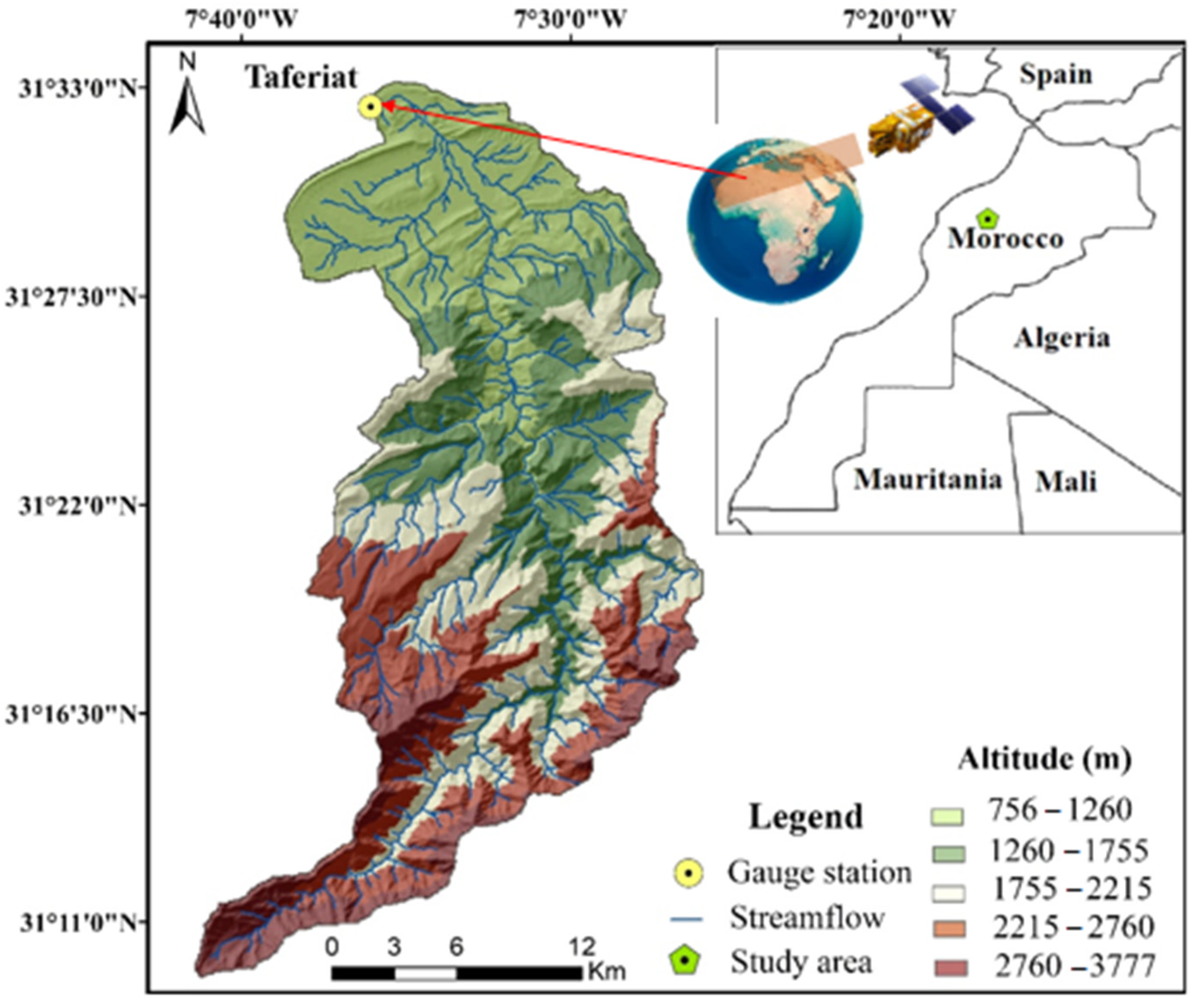
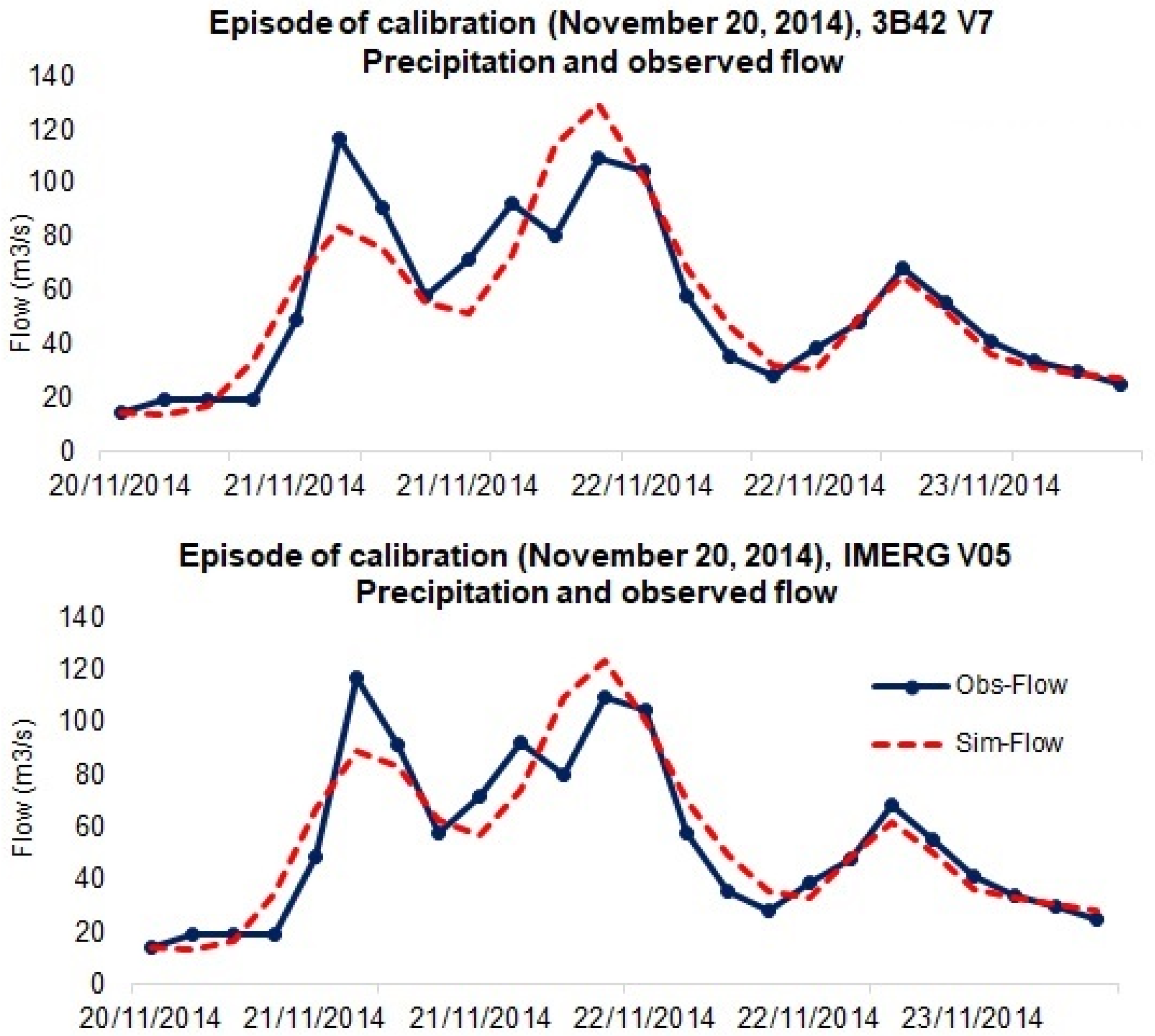
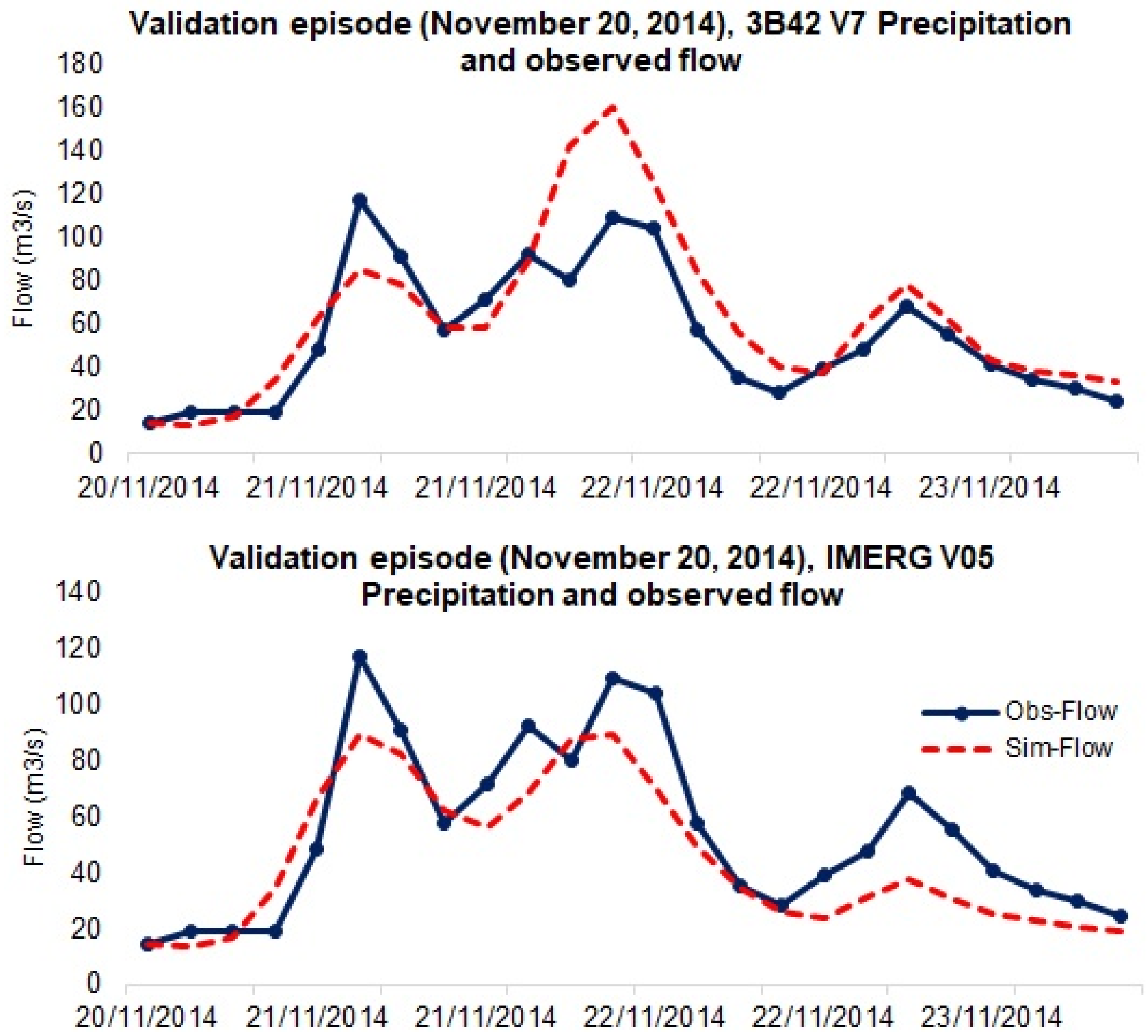

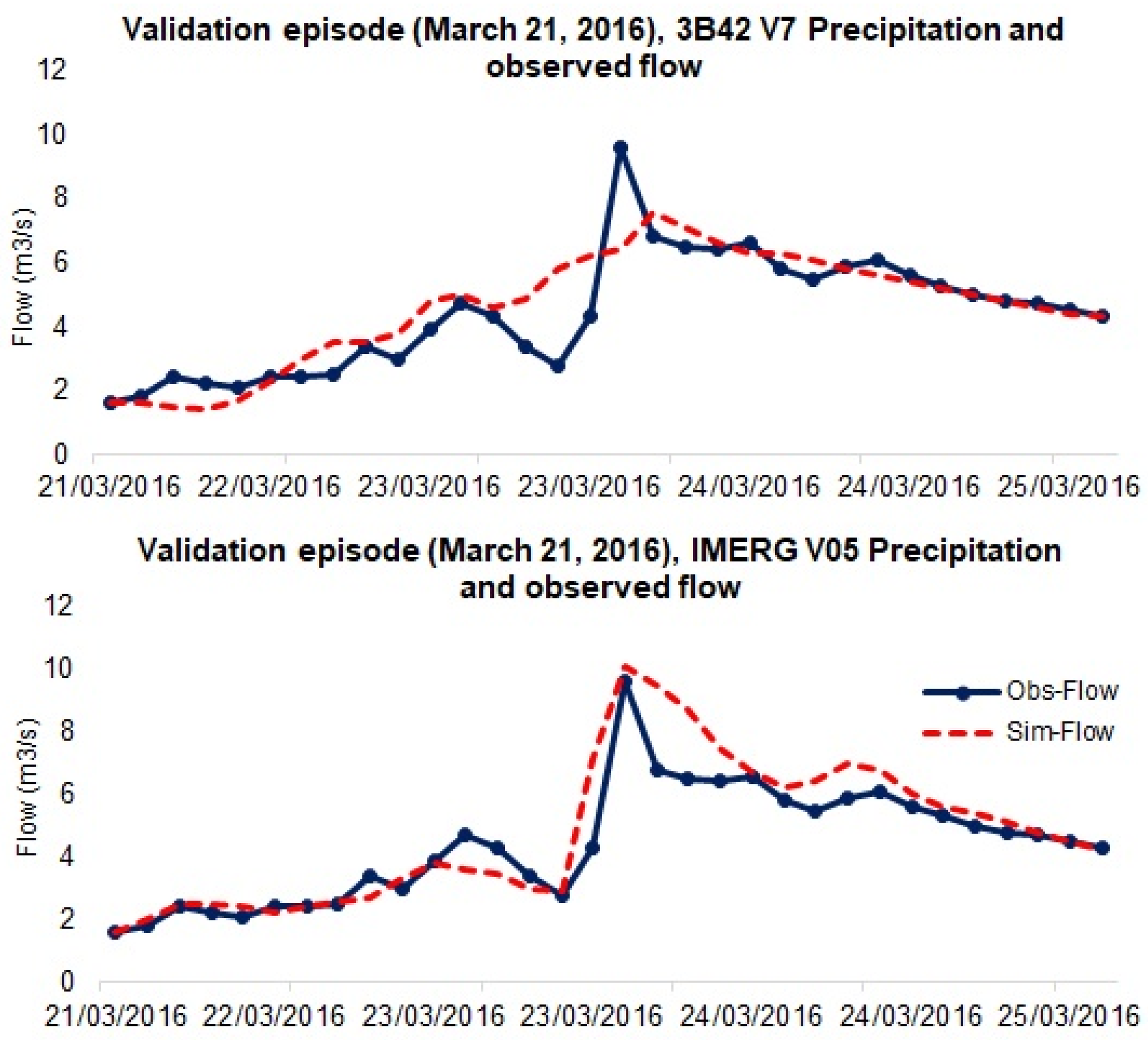



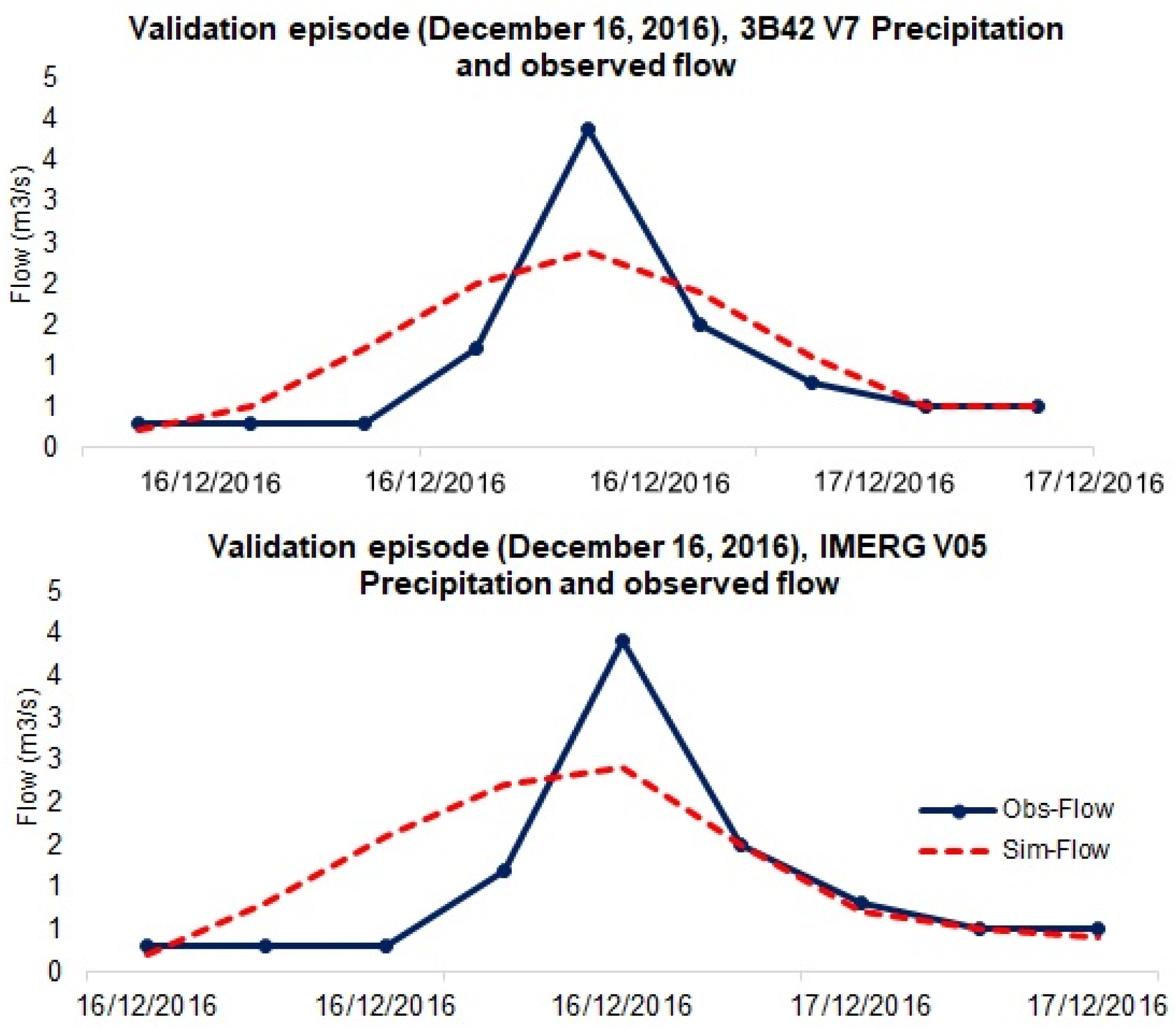
| Statistical Index | Units | Reference Values | Equation | Reference |
|---|---|---|---|---|
| Correlation Coefficient (CC) | Ratio | 1 | [40] | |
| Root Mean Square Error (RMSE) | mm | 0 | ||
| Bias | mm | 0 | ||
| Probability of Detection (POD) | Ratio | 1 | [41] | |
| False Alarm Ratio (FAR) | Ratio | 0 | ||
| Critical Success Index (CSI) | Ratio | 1 | ||
| Frequency Bias Index (FBI) | Ratio | 1 |
| TRMM | GPM | |||||||
|---|---|---|---|---|---|---|---|---|
| 3 h | Daily | Monthly | Yearly | 3 h | Daily | Monthly | Yearly | |
| CC | 0.12 | 0.38 | 0.79 | 0.94 | 0.4 | 0.59 | 0.81 | 0.86 |
| RMSE | 1.41 | 0.9 | 2.15 | 16.75 | 1.35 | 3.26 | 1.69 | 21.1 |
| Bias | 0.22 | 0.22 | 0.85 | 0.21 | 0.25 | 1.52 | 1.37 | 1.49 |
| TRMM | GPM | |||||||
|---|---|---|---|---|---|---|---|---|
| 3 h | Daily | Monthly | Yearly | 3 h | Daily | Monthly | Yearly | |
| POD | 0.13 | 0.39 | 0.89 | 1 | 0.58 | 0.82 | 1 | 1 |
| FAR | 0.79 | 0.66 | 0.08 | 0 | 0.83 | 0.81 | 0.07 | 0 |
| CSI | 0.08 | 0.22 | 0.82 | 1 | 0.14 | 0.18 | 0.92 | 1 |
| FBI | 0.65 | 1.17 | 0.97 | 1 | 3.63 | 4.37 | 1.07 | 1 |
| Model Parameters | Calibration Ranges | |
|---|---|---|
| Loss parameters | Initial Abstraction (mm) | - |
| Curve Number (CN) | 46–83 | |
| Impervious (%) | 0–10 | |
| Transform parameters | Time of concentration (HR) | 0.1–5.5 |
| Storage Coefficient (HR) | 2.6–25.6 | |
| Baseflow parameters | Initial discharge (m3/s) | 0.3–2.8 |
| Recession constant | 0.6–0.8 | |
| Ratio | 0.3–0.5 |
| Id | Events | Curve Number | Time of Concentration | Recession Constant | Nash–Sutcliffe | RMSE | |
|---|---|---|---|---|---|---|---|
| Calibration | Gauge precipitation | 20 November 2014 | 51 | 0.1 | 0.6 | 0.88 | 0.4 |
| 21 March 2016 | 60 | 0.6 | 0.55 | 0.88 | 0.3 | ||
| 3 May 2016 | 63 | 2 | 0.29 | 0.83 | 0.4 | ||
| 16 December 2016 | 60 | 9 | 0.3 | 0.58 | 0.7 | ||
| 3B42V7 | 20 November 2014 | 54 | 0.6 | 0.6 | 0.79 | 0.5 | |
| 21 March 2016 | 67 | 0.1 | 0.6 | 0.67 | 0.6 | ||
| 3 May 2016 | 65 | 10 | 0.3 | 0.77 | 0.5 | ||
| 16 December 2016 | 61 | 4 | 0.6 | 0.64 | 0.6 | ||
| IMERGV5 | 20 November 2014 | 52 | 0.1 | 0.6 | 0.84 | 0.5 | |
| 21 March 2016 | 50 | 0.9 | 0.6 | 0.84 | 0.4 | ||
| 3 May 2016 | 44 | 3.1 | 0.3 | 0.79 | 0.5 | ||
| 16 December 2016 | 62 | 6.15 | 0.38 | 0.62 | 0.6 | ||
| Mean | 0.76 |
| Id | Events | Calculated CN | Nash-Sutcliffe | RMSE | |
|---|---|---|---|---|---|
| Validation | Gauge precipitation | 20 November 2014 | 60.39 | 0.58 | 0.6 |
| 21 March 2016 | 56.98 | 0.64 | 0.6 | ||
| 3 May 2016 | 59.03 | 0.83 | 0.4 | ||
| 16 December 2016 | 55.83 | 0.51 | 0.7 | ||
| 3B42V7 | 20 November 2014 | 59.2 | 0.52 | 0.7 | |
| 21 March 2016 | 65.9 | 0.56 | 0.7 | ||
| 3 May 2016 | 63.05 | 0.61 | 0.6 | ||
| 16 December 2016 | 60.18 | 0.63 | 0.6 | ||
| IMERGV5 | 20 November 2014 | 39.5 | 0.71 | 0.6 | |
| 21 March 2016 | 50.5 | 0.74 | 0.5 | ||
| 3 May 2016 | 47 | 0.73 | 0.5 | ||
| 16 December 2016 | 49 | 0.57 | 0.7 | ||
| Mean | 0.64 |
Publisher’s Note: MDPI stays neutral with regard to jurisdictional claims in published maps and institutional affiliations. |
© 2022 by the authors. Licensee MDPI, Basel, Switzerland. This article is an open access article distributed under the terms and conditions of the Creative Commons Attribution (CC BY) license (https://creativecommons.org/licenses/by/4.0/).
Share and Cite
Benkirane, M.; Laftouhi, N.-E.; Khabba, S.; Hera-Portillo, Á.d.l. Hydro Statistical Assessment of TRMM and GPM Precipitation Products against Ground Precipitation over a Mediterranean Mountainous Watershed (in the Moroccan High Atlas). Appl. Sci. 2022, 12, 8309. https://doi.org/10.3390/app12168309
Benkirane M, Laftouhi N-E, Khabba S, Hera-Portillo Ádl. Hydro Statistical Assessment of TRMM and GPM Precipitation Products against Ground Precipitation over a Mediterranean Mountainous Watershed (in the Moroccan High Atlas). Applied Sciences. 2022; 12(16):8309. https://doi.org/10.3390/app12168309
Chicago/Turabian StyleBenkirane, Myriam, Nour-Eddine Laftouhi, Saïd Khabba, and África de la Hera-Portillo. 2022. "Hydro Statistical Assessment of TRMM and GPM Precipitation Products against Ground Precipitation over a Mediterranean Mountainous Watershed (in the Moroccan High Atlas)" Applied Sciences 12, no. 16: 8309. https://doi.org/10.3390/app12168309
APA StyleBenkirane, M., Laftouhi, N.-E., Khabba, S., & Hera-Portillo, Á. d. l. (2022). Hydro Statistical Assessment of TRMM and GPM Precipitation Products against Ground Precipitation over a Mediterranean Mountainous Watershed (in the Moroccan High Atlas). Applied Sciences, 12(16), 8309. https://doi.org/10.3390/app12168309






